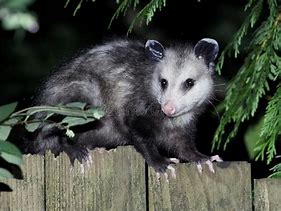Rescue Tails / Opossums: Part 2
There’s nothing better than having good neighbors! But what happens when you’re not a fan of the neighbor who just moved in? That can happen sometimes when the new neighbor has four legs, a pointy nose, and big teeth. We’re talking opossums. In last week’s Rescue Tails, we described the unique and special qualities of opossums with the hope of giving our only North American marsupial a bump upward in appreciation and respect.
But even in the best of worlds, sometimes their presence is neither appreciated nor practical to allow. So this week we’re offering some humane ways to encourage unwanted opossums to “move on” without causing undue pain or harm.
Before doing that, though, we should explain some of the realities that shelters and animal control facilities face when dealing with unwanted opossums. Our goal is that, with greater understanding, people will reconsider their choices and not demand that an animal be summarily trapped and removed.
Often, homeowners don’t want an opossum on their property out of concern for their pets (addressed in last week’s column) or to avoid property or landscape destruction, but also don’t want any harm to come to the animal. They often just want the animal to be relocated. While this sounds like a simple and humane solution, it often isn’t! Plus, it’s usually just a temporary fix. As long as there’s a standing invitation (available food) on the property, the next opossum in line will just move in. More about that later. From a biological standpoint, wildlife relocation can be problematic and counter-productive. All natural habitats have what is called a carrying capacity, which is “the number of organisms that an ecosystem can sustainably support. An ecosystem’s carrying capacity for a particular species may be influenced by many factors, such as the ability to regenerate the food, water, atmosphere, or other necessities that populations need to survive.” When an animal appears to be healthy and thriving, that’s usually an indication that the habitat is capable of supporting it.
But if an area is already at maximum carrying capacity with an established population, relocating new animals into the area can create an unhealthy competition for resources. This has the potential to throw the whole ecosystem out of balance. Plants and animals can all pay the price. In addition, here in the Keys, it’s possible to transmit disease from one population to another by moving an animal to a different island, again affecting much more than just the single animal in question.
From a humane perspective, relocation is often NOT a “happily ever after” story for the removed animal. The newcomer is thrown into unfamiliar territory, often very different from where it came, with sources of food, water, and shelter not immediately known. The search for those survival needs can bring the newcomer into conflict with those animals already established. The results can be stress, injury, and often death as the new guy on the block fights to survive with others. Also, a relocated animal may be put at greater risk from cars and predators as it attempts to find its way back to the familiarity of its native area.
So what do you do if you find yourself not wanting to remove an opossum out of respect and kindness, but don’t want to live with one as your neighbor? Consider why the opossum wants to be your neighbor in the first place, and then individually address those issues. Here are some suggestions:
- Close the restaurant! It’s not fair to invite someone over for a free meal and then punish them for showing up! Feed cats and dogs inside or during the day, and leave no food out at night. Keep in mind that bird seed also attracts opossums, so use feeders that limit spillage. Secure garbage can lids. Use a wire or metal guard (at least 18” wide) around tree trunks to prevent animals from climbing and eating from fruit trees.
- Don’t provide free housing! Spring and summer are often the times when opossums are seeking a safe space for their babies. If possible, tack wire over crawl spaces to prevent entry and keep trees cut back to limit acrobatic attic access. A bright light shining or a loud radio playing can give an attic or crawl space much less curb appeal in the opossum real estate market. But if you suspect a mother already has babies, please consider allowing her some time to relocate. Finding new housing for a family is never a quick or easy process for anyone, including wildlife.
- Discourage gardening helpers! Cayenne paper sprinkled about can discourage four-legged gardeners from digging up your landscaping and uprooting your plants.
Wildlife in general is having a harder time staying wild as more natural areas are being taken from them. They are adaptable and are finding ways to survive in spite of the myriad pressures facing them, but it can’t be easy. Let’s cultivate a generous and tolerant spirit and, whenever possible, give the wild creatures some space, allowing them to live their lives and coexist whenever possible.






No Comment